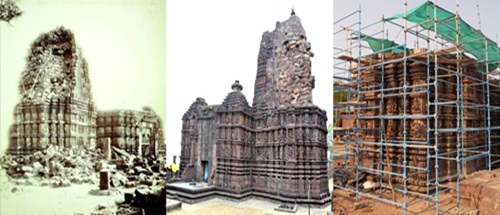The restoration work of Markandeshwar temple in Maharashtra by the Archaeological Survey of India (ASI) is in full swing. Known as the “Khajuraho of Vidarbha”, the temple of Markandadeo is situated on the bank of River Wainganga in Gadchiroli district of Maharashtra.
The temples are part of the Nagara group of temples of North India and, based on their style of architecture, date back to 9-12th centuries CE. The temples belong to Saiva, Vaishnava and Sakta faiths.
Most of the temples have a simple plan, with ardhamandapa, mandapa, antarala and garbhagriha forming the component of the entire set up.
The temples have seen large scale destruction caused on the main shrine (garbhagriha) and the very first recordings made by Sir Alexander Cunningham, who is known as the father of Indian archaeology, states that - about 200 years ago the shikhara of the main shrine and mahamandapa was struck by a lightning, which led to the partial collapse of the shikhara (the finial, north and south facade).
Sir Alexander Cunningham, born on 23 January 1814 in London, joined the Bengal Engineers at the age of 19 and spent 28 years in the British army in India, retiring as major general in 1861.
His interest in Indian history and architecture led to his taking part in the excavation of many sites in India, including Sarnath and Sanchi. He also served as the first director of the Indian Archaeological Survey (ASI). He died on 28 November 1893 in London.
The then Gond ruler renovated the temple about 120 years ago, trying to restore the fallen portions as much as possible. This restoration attempt was, however, not as per the desired conservation standards. However, the restoration of the temple by Gond ruler helped in the preservation of the religious character of this temple and it continues to attract large gathering of devotees.
The ASI initiated the largescale conservation work of the temple in November 2017. A detailed documentation process was initiated to carry out the condition mapping of the temple in order to carry out the conservation process. The documentation process revealed that originally a three-leaf masonry construction with iron clamps had been used to tie the adjacent stones of outer and inner stone walls, also, the inner area between the two walls was filled of rubble masonry with lime. Around 1,500 stone fragments were dismantled and later documented in the process.
Detailed documentation of the architectural components, thickness of joints, their colour and the quarry was investigated; including the mortar used for binding was also analyzed. Prior to the conservation process, soil Investigation studies, foundation strengthening studies, studies of old as well as new stones, beam studies with full scale testing, beam positioning, capacity of beam in flexural and compression etc. were also carried out.
The conservation process was then started by numbering each stone and components of the garbhagriha was numbered and detailed drawings / photographs of each part of the temple was prepared, showing the numbered stones. This documentation was carried out before the dismantling work, in order to restore back all the original stones in their original location maintaining their authenticity.
The stones from the temple were then dismantled in one of the most strenuous and painstaking process and they were thoroughly cleaned in order to remove dirt, dust, algae and mortar remains.
In order to achieve high degree of accuracy, following the trial and error method, critical layers of inner masonry were arranged and placed on ground for checking the exact position and then placed and fixed at their original location on the temple.
The reconstruction of the temple in stone was then carried out to its original height and form duly following the detailed drawings showing each numbered stone. The references from the older photographs were also taken to check respective North, South and West side.
The old rusted iron clamps were replaced by new stainless-steel clamps which were fixed using adhesive (hardener + resin + stone dust).
During the conservation process, all the original stone members, beams were retained and used extensively, and wherever they were found broken, they were mended together. The broken members beyond scope of mending and repairs were replaced with new ones.
As of now, the reconstruction process is in full swing and the ASI has completed the wall portion and the sikhara portion has been taken up now.
The quarry site for the stones used in the original temple construction was also identified along the banks of River Wainganga. A team of skilled craftsman are have been involved in the process of chiseling, finishing the architectural members, planning to fix them in the original form and shape.



.webp)




























